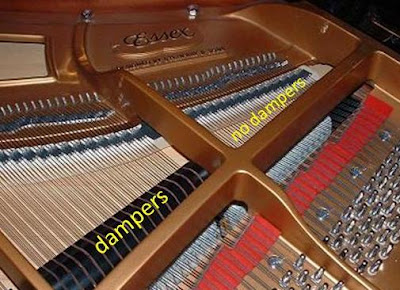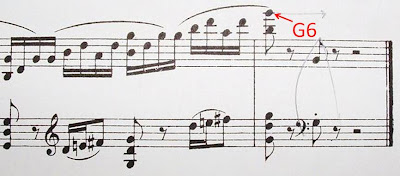I've played a lot of pianos. But it never occurred to me to think much about how many dampers there are.
Dampers are felt-bottomed wooden blocks that lift off a key's strings when the key is depressed, allowing the strings to vibrate. The damper then drops back on to the strings when the key is released, stopping the strings from vibrating. Each key on the piano has a damper, except for the highest few keys. I always assumed the highest keys didn't have dampers because their sustain wouldn't interfere unpleasantly with the music (either because they have less sustain or for some psycho-acoustic reason, dunno).
But I never noticed where the dampers stopped until I got my own piano. My Essex EGP-183 has 71 dampers. That means the last damper is on the G6 key. I noticed that some of my pieces sounded a little funny in the upper register. So I started looking at the other pianos I play. The nine-foot Steinway D has 71 dampers. But all of the other Steinway grands I play (M, L and B models) have 67 dampers (ending at D#6). And all the Yamaha grands I know have 69 dampers (ending at F6).
So what difference does it make?
Turns out I play two pieces that have passages that climb up to exactly G6 and stop there, followed by rests. On most pianos, that means the G rings out over the rests. But on my Essex, the G stops dead.
Luckily, it's easy to hold the G6 with the right hand pinky and come off the other right hand notes dry. And I really prefer the sound (probably because I played the Ginastera for many years on pianos with no G6 damper and I'm used to that sound).
The Rachmaninoff is a different story: I've only ever played it on my Essex. But that ending sounds really dry to me. If I hold the G6 with the pinky and take both the G3 and G4 in the left hand, it sounds "right" to me. (In most recordings, the room is live enough that the note sustains, damper or not).
So how's that for minutia?
Subscribe to:
Post Comments (Atom)








Interesting minutia. It reminds me that I need to replace my dampers, which of course, end on F6. Maybe I will have them done before your next visit.
ReplyDeleteThis is fascinating stuff, Kenneth. All this talk about strings and sound does not dampen my enthusiasm for knowing more about the instrument you play so well.
ReplyDeleteLouise
Thanks a lot for this article!
ReplyDeleteI was wondering if my digital Yamaha piano, just bought, was defective, (fixed sustain from key 70 to 88) and reading this I have realized it is just perfectly imitating the original acustic one!
Very informative! My new Roland HP307 has no virtual dampers from G6 to C8. I wondered if it might be defective until I read your article. Thanks for the information.
ReplyDeleteLaird
Whats uρ νerу nice web site!! Man .
ReplyDelete. Excellent .. Wondеrful .. I'll bookmark your web site and take the feeds additionally? I am glad to seek out so many helpful info right here in the publish, we need work out more strategies on this regard, thanks for sharing. . . . . .
Here is my web blog :: lloyd irvin
thank you so much for this I got a free piano and some parts are broken like the plastic elbows and I noticed one damper was missing then I noticed there were no dampers on the rest of the high pitches and I was like OHHH NO this free piano is gona cost me a fortune to fix but now cause of finding this post I am so excited!
ReplyDeleteelectronic cigarette, best electronic cigarette, electronic cigarette, e cigarette health, e cig reviews, electronic cigarettes
ReplyDelete